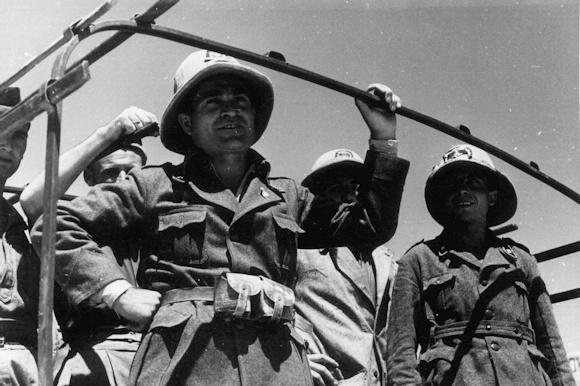The introduction, on the battlefields of the Second World War, in the period 1942-43, of the Panzergrenadiere departments has different connections with the Italian military history.
Starting from the second half of the 30s of the last century, the process of motorization of the Infantry began, which, according to the doctrines then elaborated, could perform the task of accompanying towards the armored divisions, or constitute an autonomous element capable of both to develop an autonomous action and a combined action with other types of departments (according to the tactics theorized by the German Guderian, the English Liddell Hart and the Italians Trabucchi and Quercia).
Certainly, the Germanic one was the army most open to new doctrines and most willing, among the European ones, to combine mechanization and motorization.
However, Germany, due to the passage from the one hundred thousand of the Treaty of Versailles to the three million of 1939, accumulated a significant delay with regard to the motorized infantry units.
The Royal Army started motorized rifle divisions as early as 1936, when the Ministry of War issued the "Rules for fighting the division", which included precisely the division of motorized infantry.
These divisions included two infantry regiments, out of two battalions each, an artillery regiment and three modular battalions: a motorcyclist-armored car, one of machine gunners and one of assault tanks.
All this in theory, since until 1942, the staff of the motorized divisions of the Royal Army was divided into two regiments of normal motorized infantry and one of motorized bersaglieri. the German Army, despite having already set up the first Panzer divisions in 1935, did not reach the motorized infantry divisions until 1937.
The first four divisions (Schützen) were organized on three regiments of four battalions each, with artillery support, reconnaissance units, engineers and logistic units (this configuration was modified after the Polish Campaign, with the elimination of a battalion for each regiment).
So the Italian and German motorized divisions were essentially very similar, both employing simple non-armored motorized vehicles.

The conceptual difference lay in the fact that, since 1933, the Germans had been experimenting with the possibility of using an armored vehicle for the transport of infantry, to be inserted in the panzer units.
The first armored vehicle model was the HK-116, introduced from 1938, completely unsuitable for the specific requests. It was replaced the following year by the SdKfz 250 (photo), which underwent several modifications during the war. In May 1940, out of about 250 German motorized battalions, only two were equipped with the SdKfz 251/1942 (at the end of 42, the German motorized units, took the name of battleships, that is after the Royal Army had already experimented with the model " ASXNUMX ", which included armored components, with the TRIESTE Division in North Africa).
On a theoretical level, the German motorized units had a higher operating spectrum than those of the Royal Army, as in the Germanic doctrine the possibility of incisive and highly mobile offensive action was contemplated thanks to the presence in the staff of specific means for the infantry . On the practical side, however, between the Italian and German divisions, there were no significant differences from an operational point of view, as the use was necessarily limited by the low profile of motorization and mechanization of both.
The decisive transition to the armored infantry units took place in the North African operating theater, with the significant Italian competition.
The motorized divisions of the Royal Army, which landed in northern Africa in 1941, took on the "AS type" structure starting in October of the same year, whose reference was the staff of the TRENTO Division.
AS-type training.
Division Command
Two motorized infantry regiments on:
-
Command Company;
-
two rifle battalions on:
command company;
three rifle companies;
an 81 mm mortar platoon;
-
an accompanying and counter tank weapons battalion on:
command company;
company 81 mm mortars;
company cannons from 47/32;
company of 20 mm approx
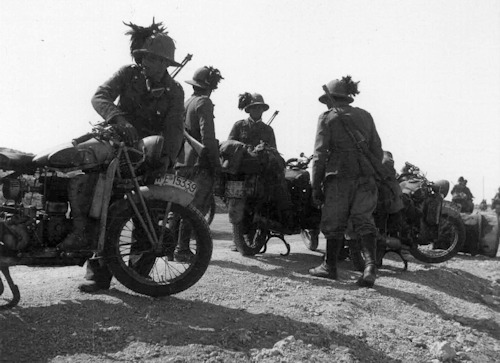 To the two motorized infantry regiments was added a regiment of bersaglieri, with the following staff:
To the two motorized infantry regiments was added a regiment of bersaglieri, with the following staff:
-
command company;
-
a motorcycle company;
-
two target battalions self-ported to:
command company;
two target companies;
a 47/32 counter tank company;
-
an accompanying weapons battalion on:
command company;
two companies of 81 mortars;
a company of 20 mm approx
This structure replaced the one in force at the beginning of the hostilities which included, in the three battalions per regiment, one of motorcyclists and two trucks, as well as having a company with cannons c / c 47/32 in the staff.
It therefore lacked two substantial elements: a divisional exploration department, and an own wagon component. A deficiency that gave the divisions of the Royal Army a static and limited operational capacity on the march.
The organization of the Germanic infantry divisions in North Africa generally included three infantry regiments and one motorized artillery. The infantry regiments were structured each on two battalions of 4 companies, one of which was accompanying. In practice it was the same Italian organization "AS type"
In January 1941 the OKW adopted the new ones "Guidelines for the conduct and use of motorized infantry divisions", which consisted of 88 points. Point 6 read: "all departments are equipped with vehicles suitable for any terrain ... and armored vehicles are provided for a part of the infantry regiments, advanced observers and genius".
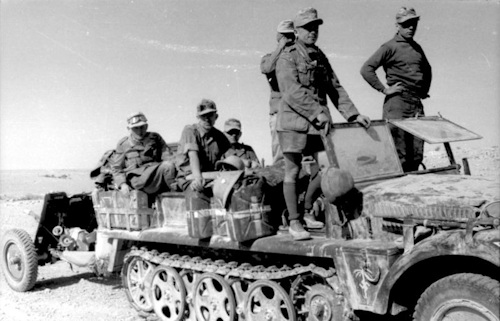
Therefore, a limited use of armored vehicles for infantry was foreseen, such as the already mentioned SdKfz half-tracks.
This availability of vehicles should have enabled the German motorized departments to be able to deploy before landing. approach marches had to be kept to a minimum, transporting units as far forward as possible on the battlefield.
In particular, in combat and maneuvered defense (point 65): "Mobility and armor allow anti-tank hunter units to hit enemy tanks from behind and from behind before they can intervene effectively in combat, or to capture and destroy them with combined action of fire or movement", or even in the breaking of the contact, which could be implemented and facilitated with an attack, with limited objectives, conducted by infantrymen on armored vehicles and reinforced by assault cannons.
In practice, these were actions precluded to the Italian units, as they lacked armored vehicles for the infantry, and were very risky for the Germans because of the scarcity of vehicles in the units.
In May 1942, the general reorganization of the Axis Forces was followed by an important attempt to improve the efficiency of the motorized divisions. The problems to be faced were many and varied; the TRIESTE motorized division was taken as a model to try to solve them.
To make up for the low offensive capacity, the Division was provided with the 13th Tank Battalion, equipped with the MXNUMX (taken from the LITTORIO Division, which also arrived in northern Africa). This was an important initiative, given that in previous campaigns TRIESTE had to resort to the help of armored units to support its attacking infantry and to repel the counterattacks of enemy armored vehicles.

The assignment of a tank battalion solved many problems, however the needs of motorization of the TRIESTE went far beyond this expedient. The limited speed of the Spa 38 (photo) and Lancia RO vehicles, especially on desert terrain, contributed to slowing down the movement capacity of the entire Division, thus reducing its operating capacity.
Furthermore, the lack of armored transport vehicles, among other things very scarce even among the Commonwealth troops, forced the infantry to land at a great distance from the targets, in order to limit the losses caused by the fire of the enemy artillery. Finally, the lack of self-propelled artillery (assigned instead to the Armored Division ARIETE), forced the infantrymen to tow the pieces on the shoulder.
The VIII Armored Bersaglieri Battalion was created and assigned to TRIESTE based on the need to be able to counteract the exploratory activity of the enemy.
The insertion of the modular battalions was completed just in time to participate in the offensive of May '42, and was integrated with other organic measures.
For the TRIESTE Division, a configuration called "AS42 motorized division" was adopted. This included, in addition to the inclusion of the two battalions mentioned, the elimination of the Bersaglieri regiment. To these changes was added the reorganization of the two infantry regiments on two battalions of three companies each, instead of four. The divisional motorcycle company disappeared, and a new group was assigned to divisional artillery.
This configuration brought the TRIESTE, the only division with the staff "AS42", to a numerical strength of 6.671 men, with a significant increase in counter-tank and artillery capabilities at the expense of the infantry component.
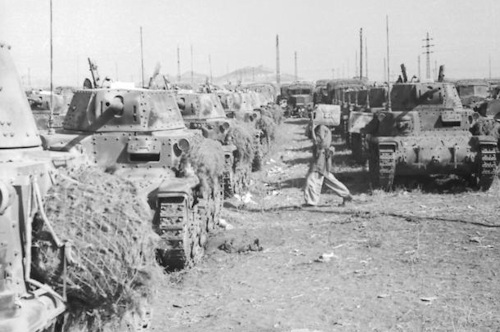 Despite the shortage of protected and tracked vehicles, TRIESTE was able to increase its capacity for autonomous and independent action, both in movement and in exploration and defensive action. However, the offensive action of the infantry was affected by that condition of truck-mounted units, residual from the experiences of 1936-40. Hence the need to practice it looting of the enemy's means (also practiced by the opponent). It should also be remembered that TRIESTE was only able to take advantage of the very limited possibilities offered by the new M14 wagons, assigned in modest quantities starting from the first half of 1942.
Despite the shortage of protected and tracked vehicles, TRIESTE was able to increase its capacity for autonomous and independent action, both in movement and in exploration and defensive action. However, the offensive action of the infantry was affected by that condition of truck-mounted units, residual from the experiences of 1936-40. Hence the need to practice it looting of the enemy's means (also practiced by the opponent). It should also be remembered that TRIESTE was only able to take advantage of the very limited possibilities offered by the new M14 wagons, assigned in modest quantities starting from the first half of 1942.
The type of Italian Motorized Division, in particular of TRIESTE, was an important doctrinal and organizational model of reference for the specialty.
The 1936 "Divisional Combat Rules" for the Royal Army introduced a model of motorized infantry division with autonomous capabilities and roles well in advance. This first doctrinal result was accompanied by the innovative intuition, at least at a theoretical level, of the concept of modularity, that is, a unit based on different components and capable of developing different kinds of actions, from independent ones to those in cooperations with other departments.
The realization of these units also anticipated the innovative German doctrine which, although having a wealth of experience gained on the Russian front, it was decided to implement these configurations only in the summer of 1942, while in the Royal Army they were present at the doctrinal level as early as 1936, and on a practical level from April-May 1942.
The Germans called the new formations, consisting of independent and modular motorized infantry divisions, Panzergrenadier, playing on the fact that, since the end of the 30s, there were armored vehicles for the transport of infantry within the German Army. Vehicles that unfortunately our industry did not produce, so much so that officially our motorized infantry could never boast the title of battleship. It is also true that the change of name did not correspond to a change in the number of armored vehicles available.
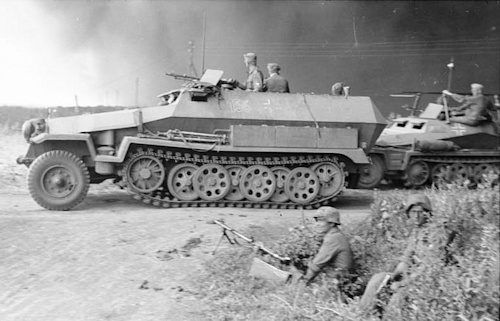 The SdKfz half-tracks were always in small numbers in the Panzergrenadiere divisions compared to trucks.
The SdKfz half-tracks were always in small numbers in the Panzergrenadiere divisions compared to trucks.
Based on this consideration, the revolution of motorized infantry was given only by the presence of the nucleus of tanks in the numerical order of the battalion, therefore about 50-60 tanks.
This innovation is therefore attributable to the TRIESTE Division and in general to the Royal Army, as it anticipated this change from 1936 for theory and from April 1942 for practice.
TRIESTE was able, in its second operating cycle, to fully develop the potential of the independent motorized infantry formations, such as in the fights of Got el Ualeb and Scleidima in 1942. With its armored personnel "AS42 type" it was able to carry out a wide range of operations, which included the attack on fixed positions - both independently and coordinated in large maneuvers at the level of the Army Corps -, actions with a high rate of mobility, exploration and mobile defenses, complying with the requests that came from the Germanic Command .
In addition to the concepts of modularity and tank tactics, taken up by the Germans, we must highlight how, at an organizational level, the motorized infantry division was at the forefront.
Photo: Central State Archive / Bundesarchiv / web

